Page 7


The McDonald Observatory
Article and Photos by Ginger Wentrcek
The McDonald Observatory complex is home to the Hobby-Eberly Telescope, the Harlan J. Smith Telescope, the Otto Struve Telescope, and other smaller telescopes. The McDonald Observatory was originally endowed by Texas banker, William McDonald, who left approximately $1,000,000 to the University of Texas for the construction of an astronomical observatory. However, after his death, the will was challenged by relatives, and, after a long legal fight, the University of Texas decided to cut their losses and settled with them for $850,000. Shortly thereafter, construction of the observatory began on Mt. Locke, located in West Texas, with dedication following on the completed project in 1939. UT contracted with the University of Chicago to operate the observatory, and control was transferred to the University of Texas in the 1960s. Today, the observatory is funded through special items in the Texas state budget.
- Some of the darkest skies in North America are located in this area of Texas.
- A majority of the nights are clear and there is very little rainfall.
- This area is far from sources of artificial light, which assures dark skies for the operation of the telescope.
Today, Fort Davis and the surrounding communities have voluntarily established strict lighting codes covering exterior lighting to combat light pollution and preserve the dark skies.
McDonald Observatory - A Small Community
Although the McDonald Observatory complex is not an incorporated town, it is the 3rd largest settlement in Jeff Davis County and has its own water system, waste water system, power distribution system, and internet system.
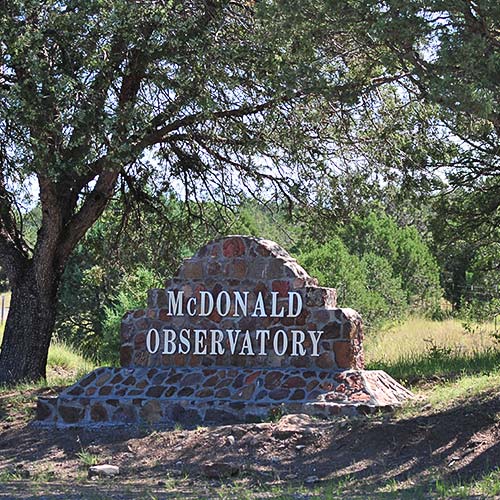
Entering McDonald Observatory grounds
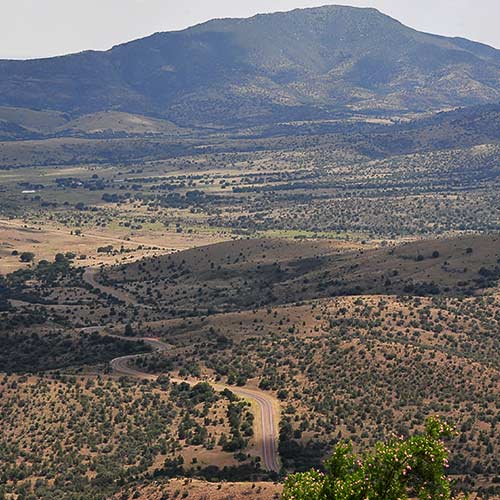
Little rainfall and isolated location
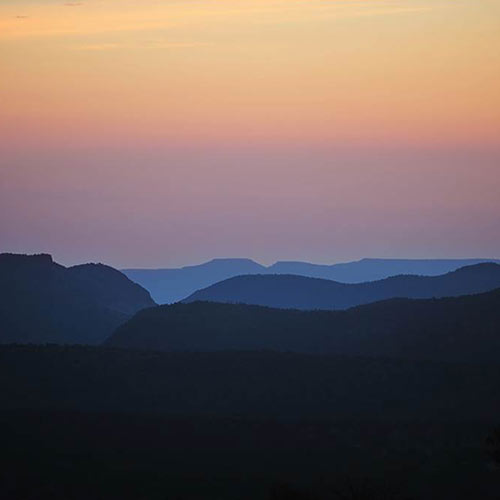
Evening skies prior to onset of darkness
Hobby-Eberly Telescope
The Hobby-Eberly Telescope is one of the world's largest optical reflecting telescopes. Construction started in 1994 and was completed in 1996. Because of the configuration of the segmented mirrors, it was built for approximately 15-20% of the cost of other 9-meter class telescopes. With a telescope weight of 80 tons, it is optimized for spectroscopy and can see 70% of the skies. To control the telescope, astronomers sit in a room that is located in an adjacent building.
The Mirror
Ninety-one mirror segments, each in the shape of a hexagon, are placed together to form the giant mirror that is 433 inches in diameter. Weighing 13 tons and constructed of Schott “Zerodur” (zero expansion glass ceramic), the mirror looks like a honeycomb.
Weighing about 250 pounds each, the 91 identical hexagonal segments of the primary mirror array measure 1 meter (39.37 inches) side to side, and each mirror is 2.05 inches thick. A blue truss supports the mirror segments.
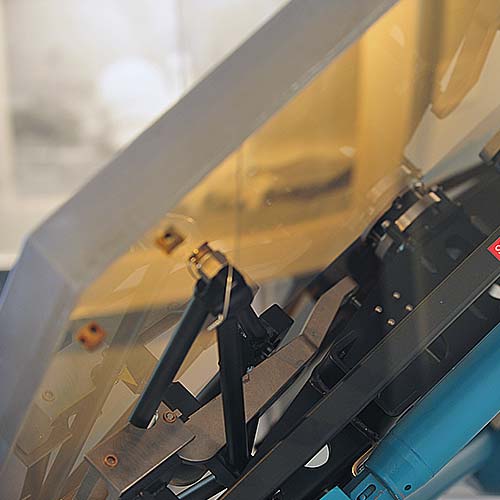
Hexagonal segment of the primary mirror on display

Astronomers work in adjacent building to telescope.
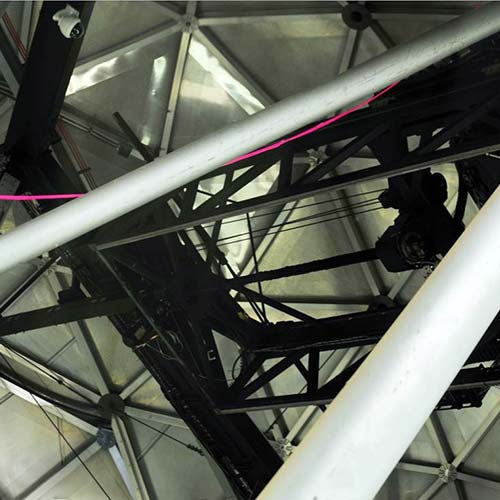
Primary mirror structure and tracker
Techniques for Cooling the Giant Mirror
To keep the giant mirror cooled, the dome is coated with silver tape that reflects more sunlight than its original white paint. Giant louvers in the bottom of the dome, similar to giant garage doors, are opened to allow more outside air to flow over the telescope. In addition, an industrial-strength air conditioning system helps to keep the dome cool during the day.
Aligning the Mirrors
A laser-alignment system, located in a 90-foot tower, is used to keep the 91 mirrors aligned. As the earth rotates, the tracker follows the stars as they drift across the big mirror below. The 91 segments must be aligned exactly to form a perfect reflecting surface, and, each night, the mirrors are aligned several times, with other alignments performed periodically.
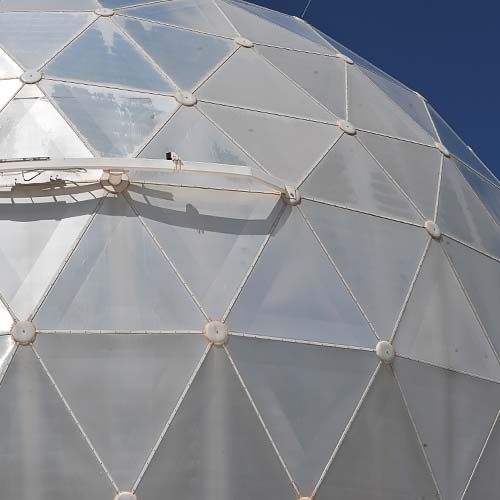
Coated dome helps cool the observatory
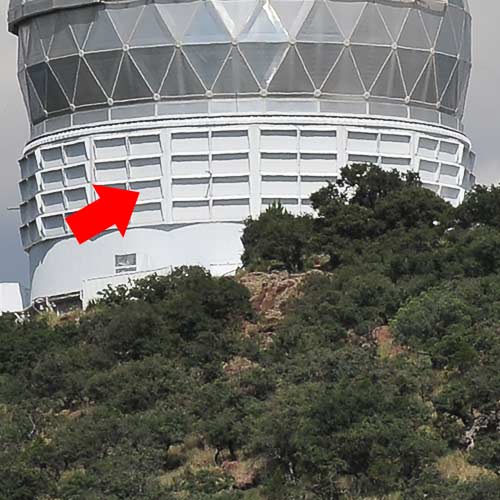
Air flows through louvers at base

Tower contains alignment system
Supporting and Upgrading the Telescope
A concrete pier supports the four foot pads of the telescope's base, and industrial air bearings rotate the structure. Eight ball bearings are used to raise and change the azimuth of the telescope. To propel the structure, two drive wheels are used.
The truss that supports the 27,000 pound mirror is the same type that is used to hold up large commercial roofs; however, because of the demands on this extraordinary structure, it cannot be classified as an ordinary truss. A German company manufactured the structure which includes 383 nodes, 1,747 struts, very few interchangeable parts, and was manufactured to a precision of about one-tenth the thickness of a human hair - 0.0004 inches.
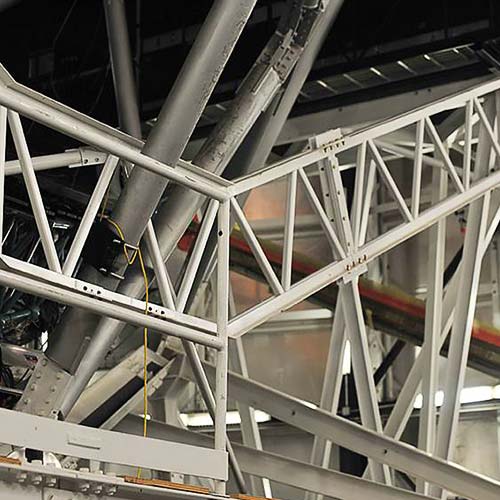
Section of interior structure
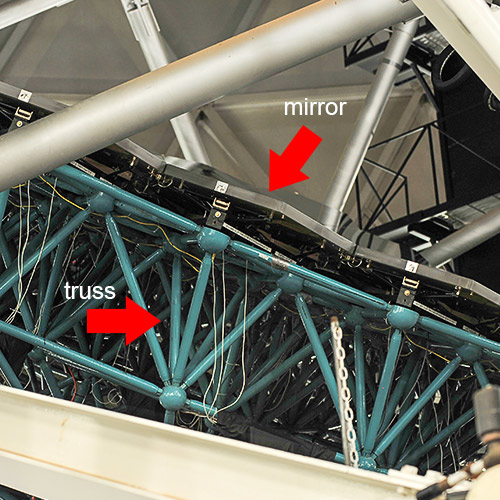
Blue truss supports primary mirror array
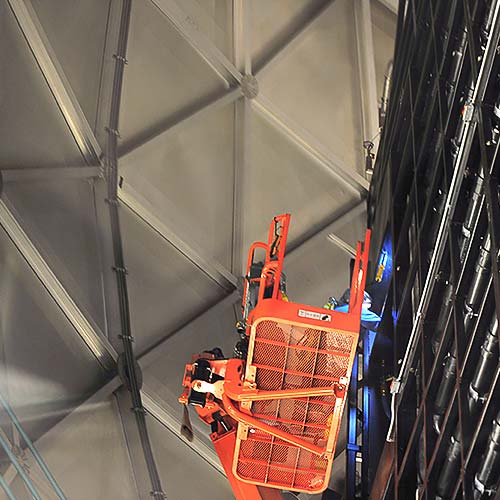
Workers upgrading telescope for HETDEX
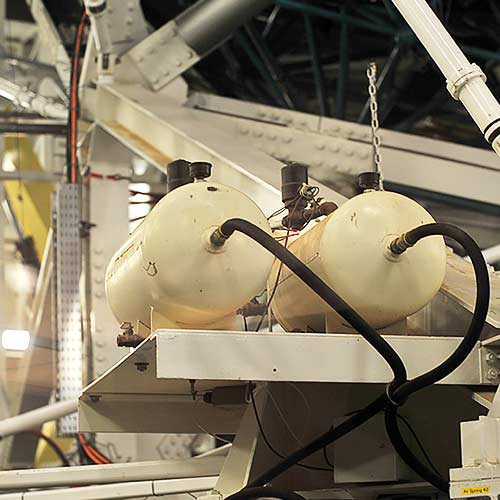
Air bearings associated with one of the foot pads
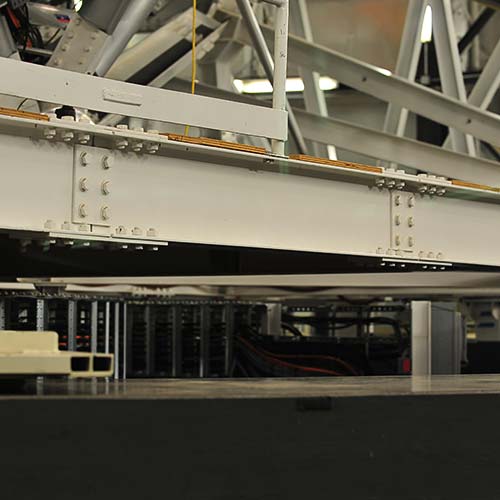
Rotating base for telescope

Interior structure
Hobby-Eberly Telescope Dark Energy Experiment - HETDEX
Increasing the telescope's field of view from 4' to 22' in a major upgrade,TAMU and UT collaborated on this monumental project to support the two medium and high resolution spectrographs, The Visible Integral-Field Replicable Unit Spectrographs, VIRUS, will be used for 3 years to collect data on 1,000,000 galaxies that are 9 billion to 11 billion light years away. The HET Dark Energy Experiment (HETDEX) study will help determine facts about the Big Bang and determine if current laws of gravity are correct. The goals are to:
- Reveal each galaxy's distance
- Determine how fast it is moving away from us
- Determine how fast the universe expanded at different times in its history
- Help us learn more about dark energy
Astronomers who wish to use the telescope to conduct research are selected through a competitive process. They must each submit proposals for research projects, and then the lucky few are selected based on their submissions.
Harlan J. Smith Telescope
The Harlan J. Smith Telescope, located on Mt. Locke and built with the assistance of NASA to study the solar system, provides a wide, deep view of distant galaxies. This cross-axis equatorial telescope can rotate 360 degrees and tilt from an almost horizontal position to a straight up position. Weighing 160 tons and measuring 32 feet in length, construction began in 1964 and was completed in 1968.
Uses for the 107 Inch Telescope
The Apollo astronauts left a laser on the Moon, and, for almost a decade, this laser was reflected through the telescope. The study revealed:
- a more exact distance from the earth to the moon
- a better understanding of the moon's interior
- a test of Albert Einstein's theory of General Relativity
This study was later moved to a telescope on Mount Fowlkes.
The Harlan J. Smith telescope continues to be used every clear night of the year to:
- study the compositions of stars
- study motions of galaxies
- search for planets around other stars in our galaxy
How the Harlan J. Smith Telescope Works
An astronomer operates the telescope from inside a heated, air-conditioned control room with no outside windows. The astronomer has a list of targets, enters them into a computerized control system, and then studies that region of the sky through a television monitor. A spectrograph, used to collect data, is one floor down.
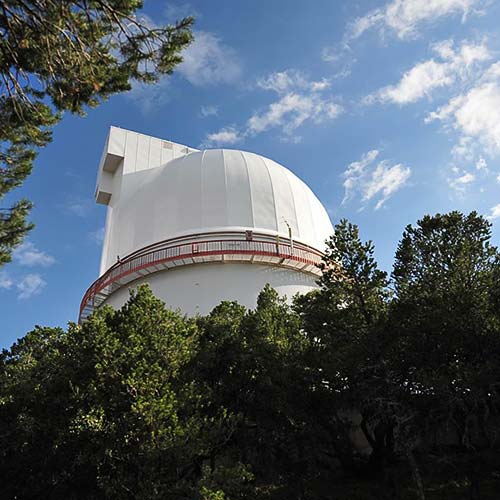
Outside dome of 107 inch telescope
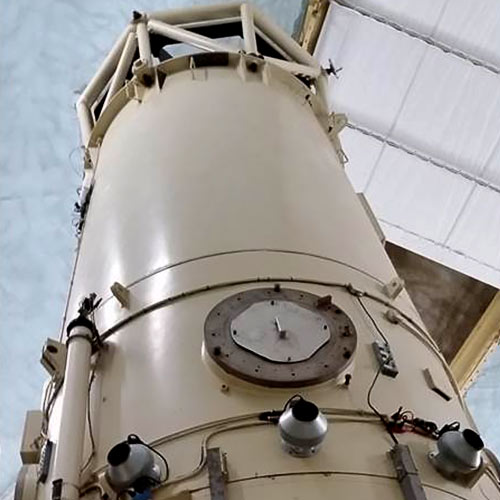
107 inch Harlan J Smith telescope
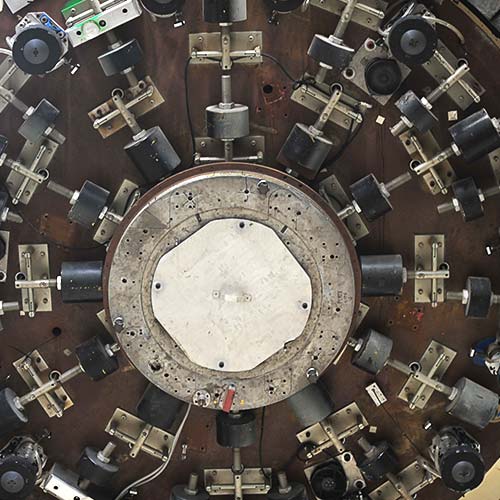
Cassegrain Focus Outlet
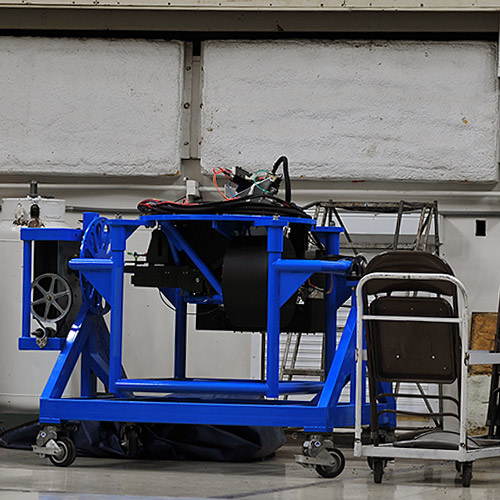
DIAFI, a computerized instrument used for CCD imaging, on its transport/service frame
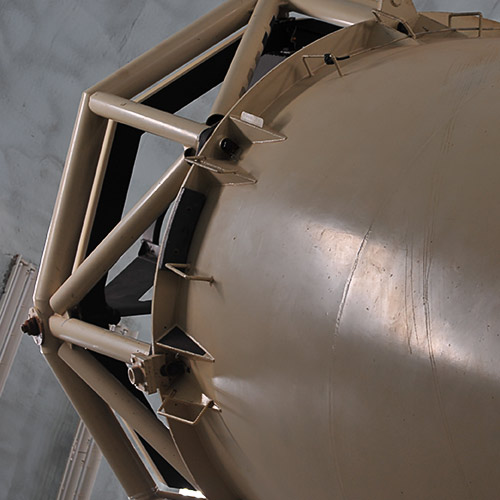
Removable Secondary Mirror Cage and rack

Side view of telescope tube
Victim of Handgun Assault
In February, 1970, a hired worker, suffering from mental problems, attacked the telescope in an act of vandalism. The employee took a handgun to work, fired one shot at his supervisor, and then fired the remaining rounds into the telescope's primary mirror. His goal - break the mirror. The mirror did not break from the gunshots; so, he promptly ran down the telescope tube and started hitting the mirror with a hammer. He still had no luck; the mirror did not shatter. The rest of the staff rushed to the attacker and subdued him. Although the telescope was not destroyed, the gunshots rendered it the equivalent of a 106 inch telescope. It only affected the amount of light the telescope could collect, not the quality of the images.
The Big Oops!
Careful examination of the floor under the giant 107” telescope will reveal a big dent. One year, an employee was moving the telescope and did not pay close attention to what he was doing. The bottom of the telescope hit the floor and left a dent in the area where it made contact. The telescope was not harmed, and the employee was not dismissed. In fact, he eventually received a promotion.
Other Telescopes
In 1938, the 82 inch Otto Struve Telescope was completed. Today, it is used extensively by University of Texas astronomers, graduate students, and offered for Special Viewing Nights when not in use by astronomers. The 0.8-meter telescope has a large field of view and is perfect for large search and survey projects.
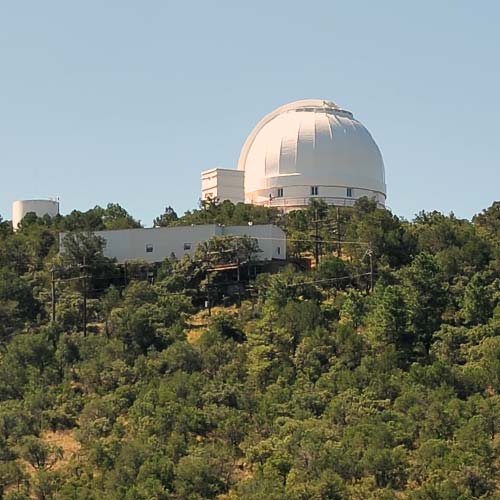
Otto Struve Telescope - 82 inch

0.9-meter Telescope - also called “the 36-inch”
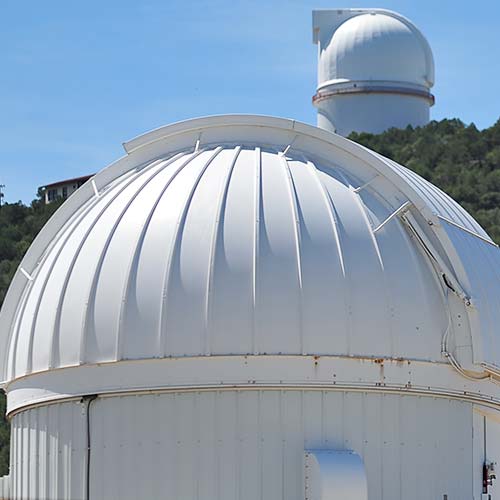
8-meter Telescope
Astronomers' Lodge
Astronomer's Lodge is not available to the general public, with one exception. Holders of Special Viewing Night tickets may stay in one of the rooms, if space permits, for the Special Viewing Night only. Occupancy rates vary. Otherwise, accommodations are intended expressly for astronomers and staff who are on official business at McDonald Observatory.
Rebecca Gale Telescope Park - Frank N. Bash Visitors' Center
There are three 20-foot Ash domes in the telescope park:
- RCOS 16 inch Ritchey-Chrétien telescope - a specialized Cassegrain telescope
- 22 inch classical cassegrain
- 24 inch specialized Cassegrain telescope, jointly designed and built by Dr. Alan Y. Chow and Wayne Rosing
The visitor center offers daily tours, displays, and solar observing opportunities. A 1,530 pound meteorite,consisting almost entirely of iron and nickel, rests on display inside the visitor's center. It was discovered by a 7 year old boy in 1903, about 15 miles away from its current resting site.

Astronomers' Lodge - red lights only
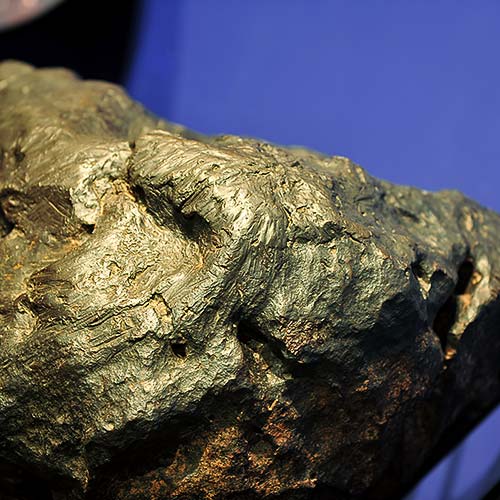
1,530 pound meteorite
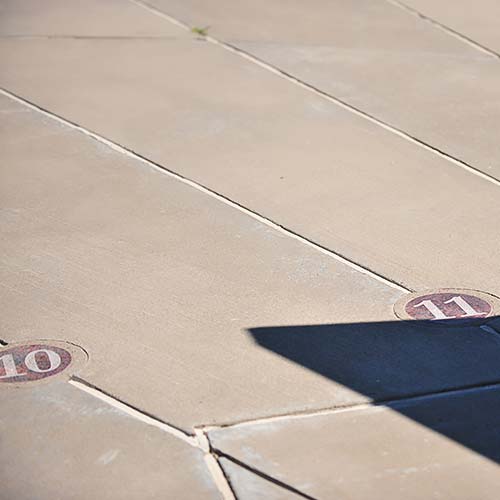
Shadow from sundial at Visitors' Center
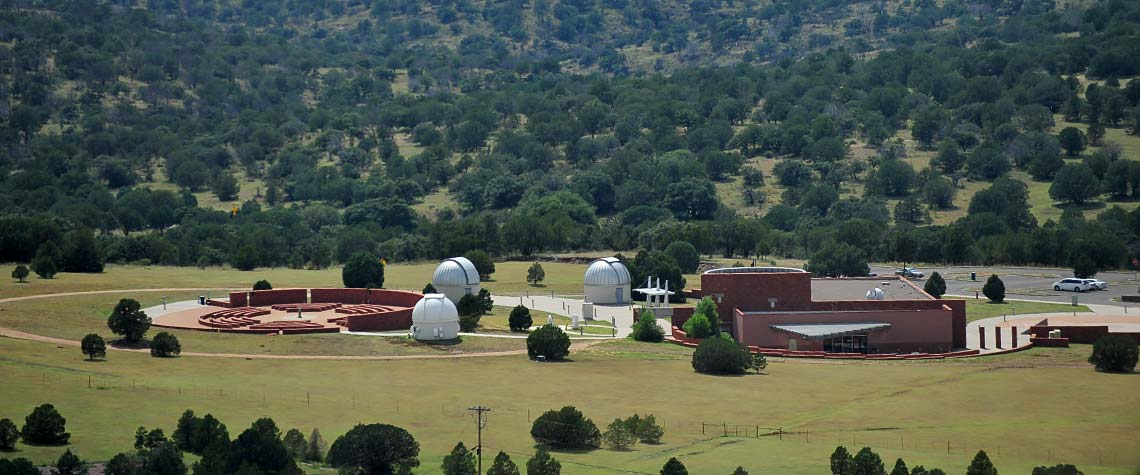
Telescope Park and Visitors' Center
Click here to see if tickets are available for any of the Special Viewing Nights.
